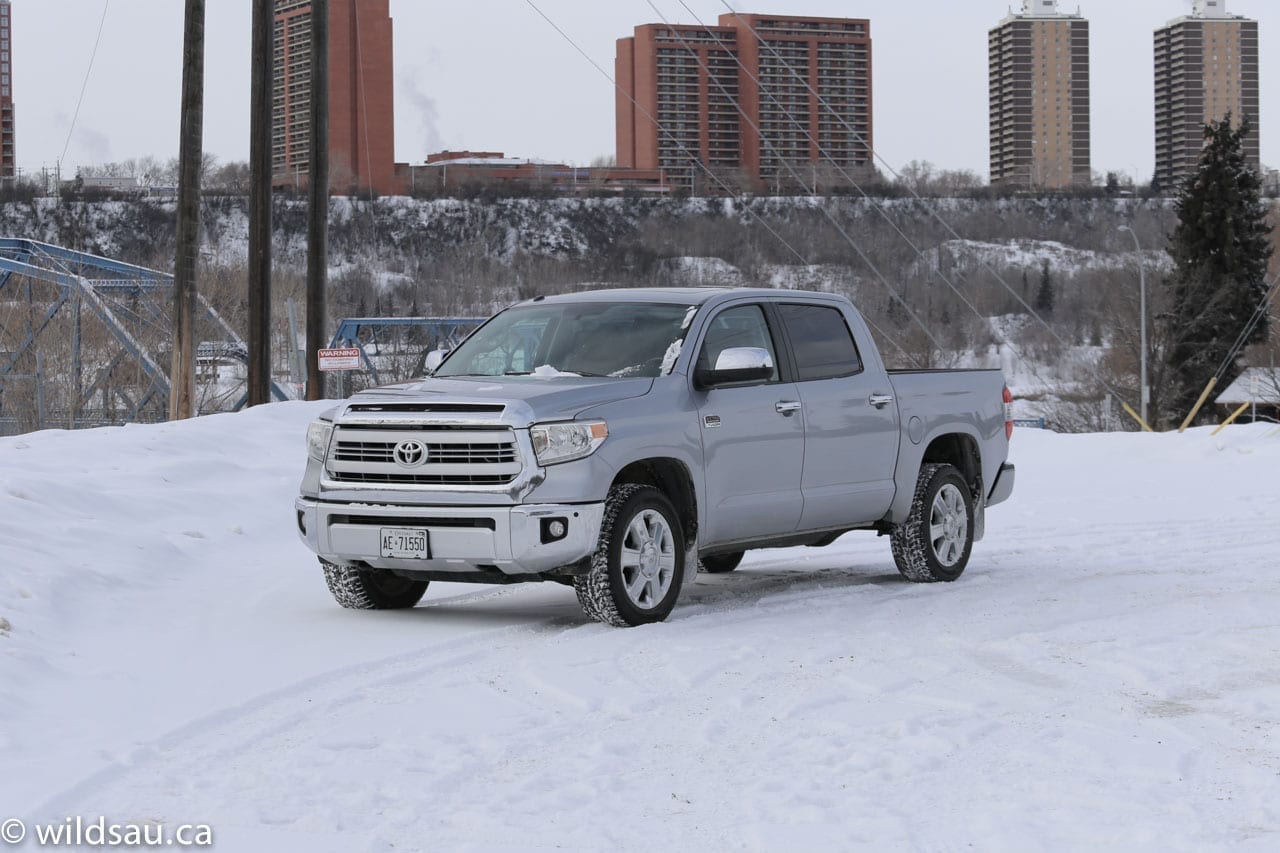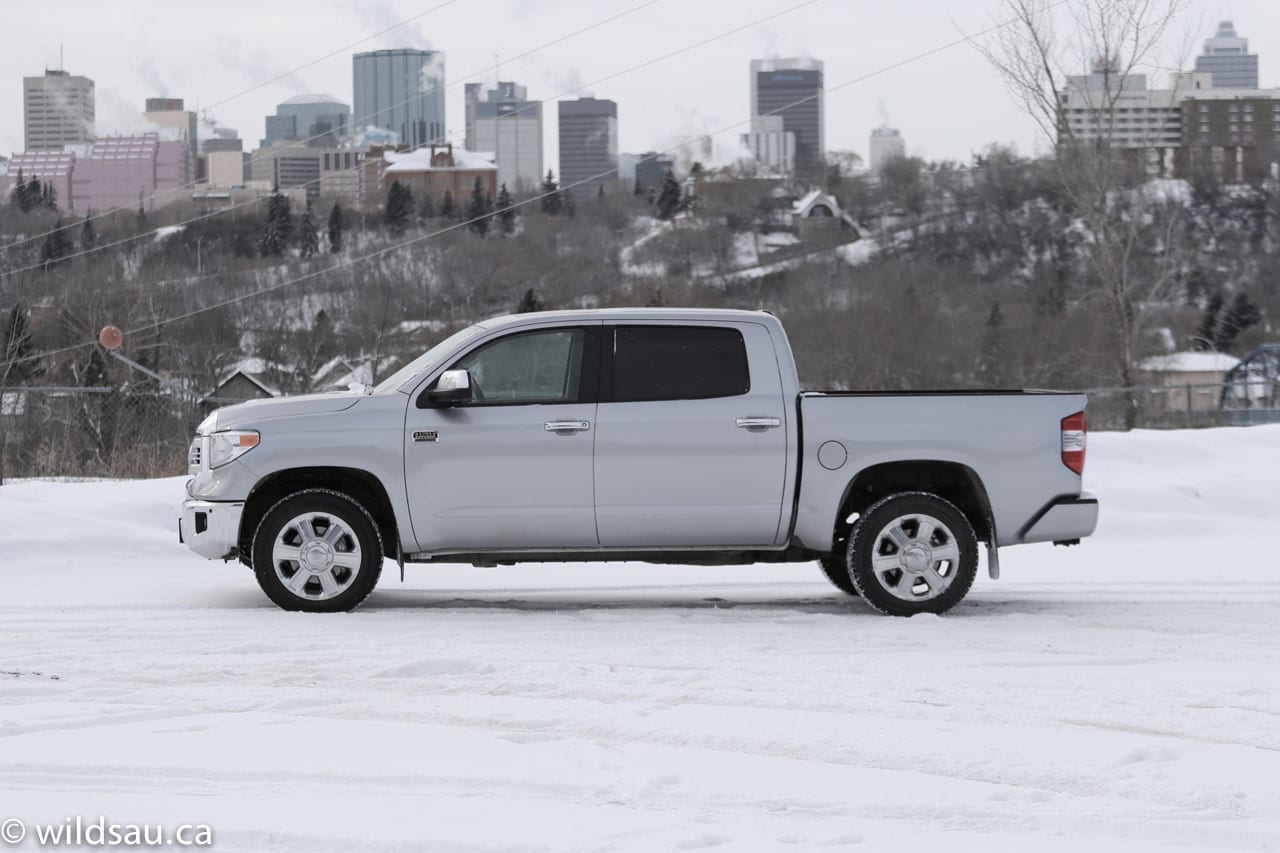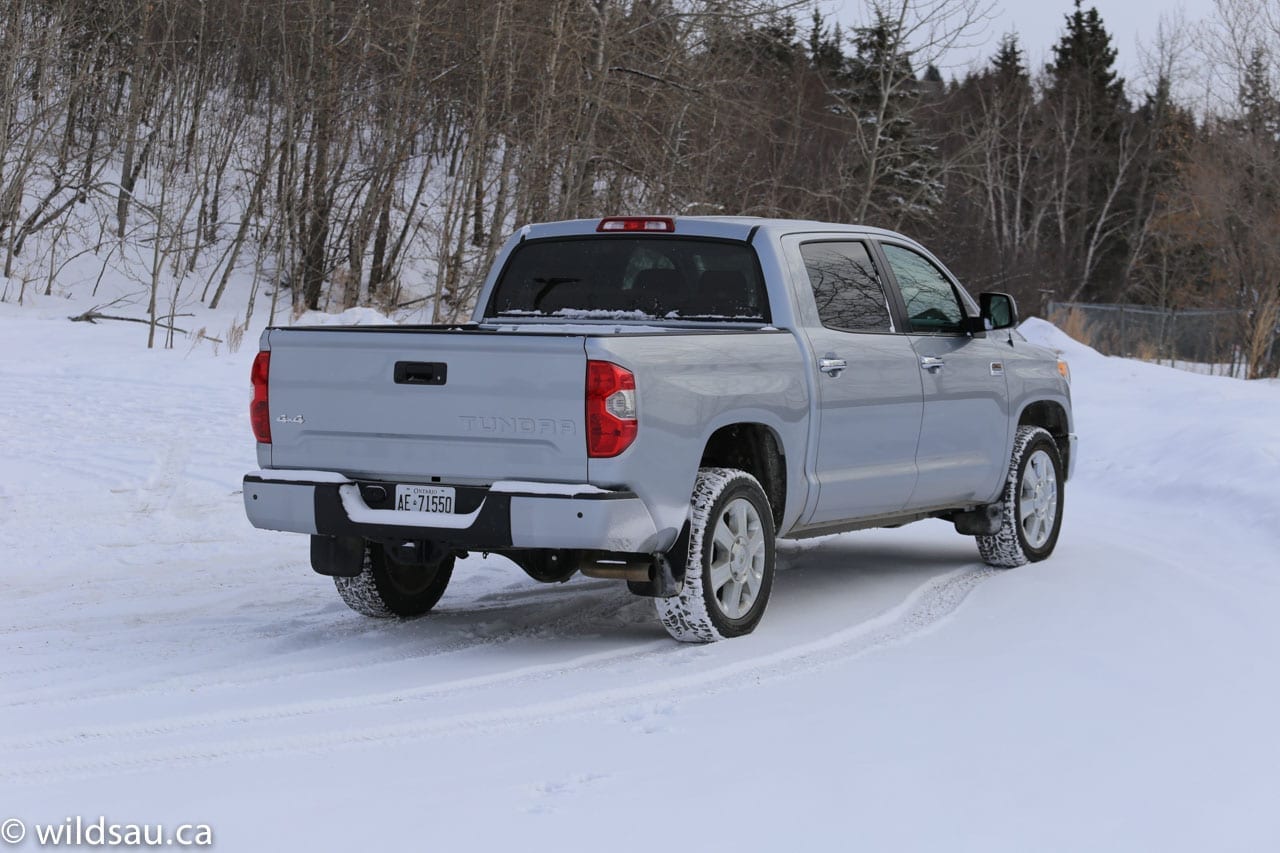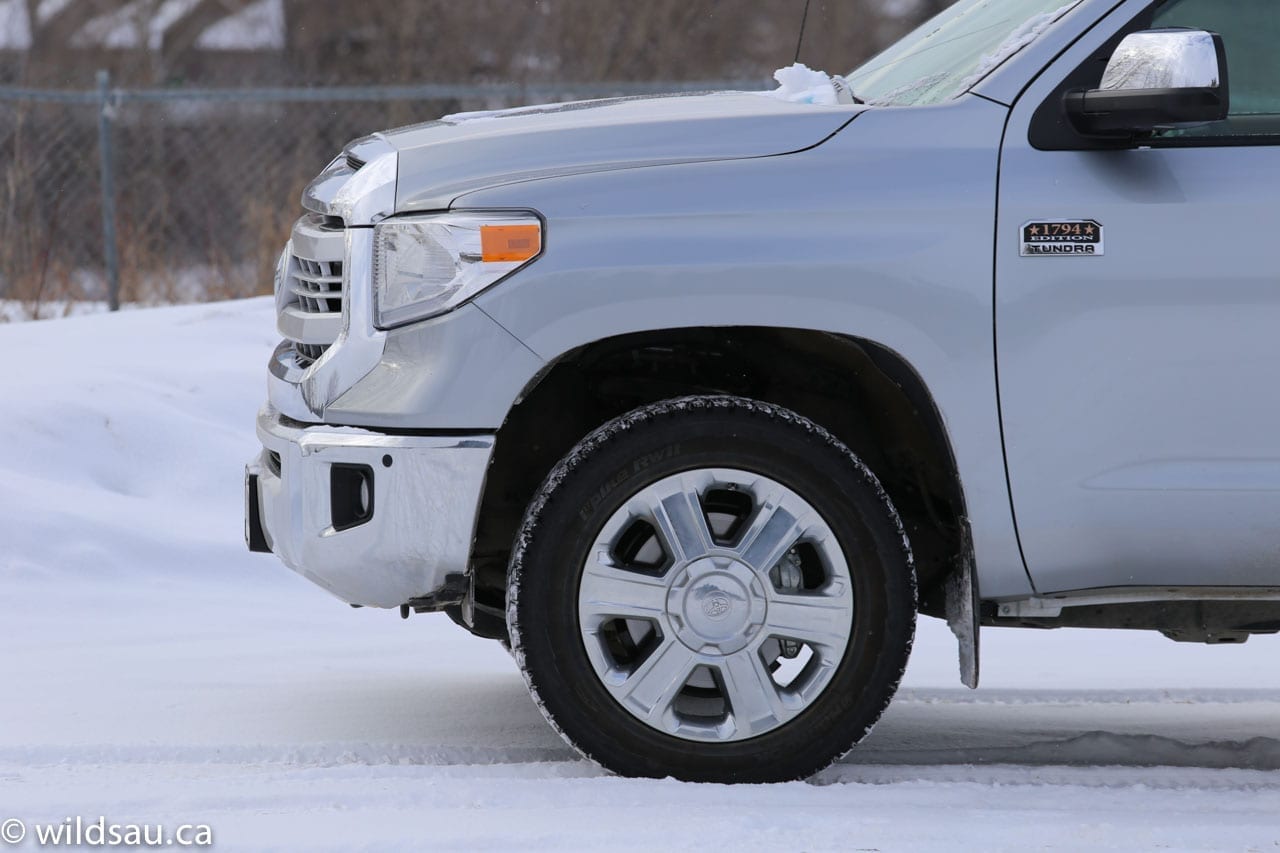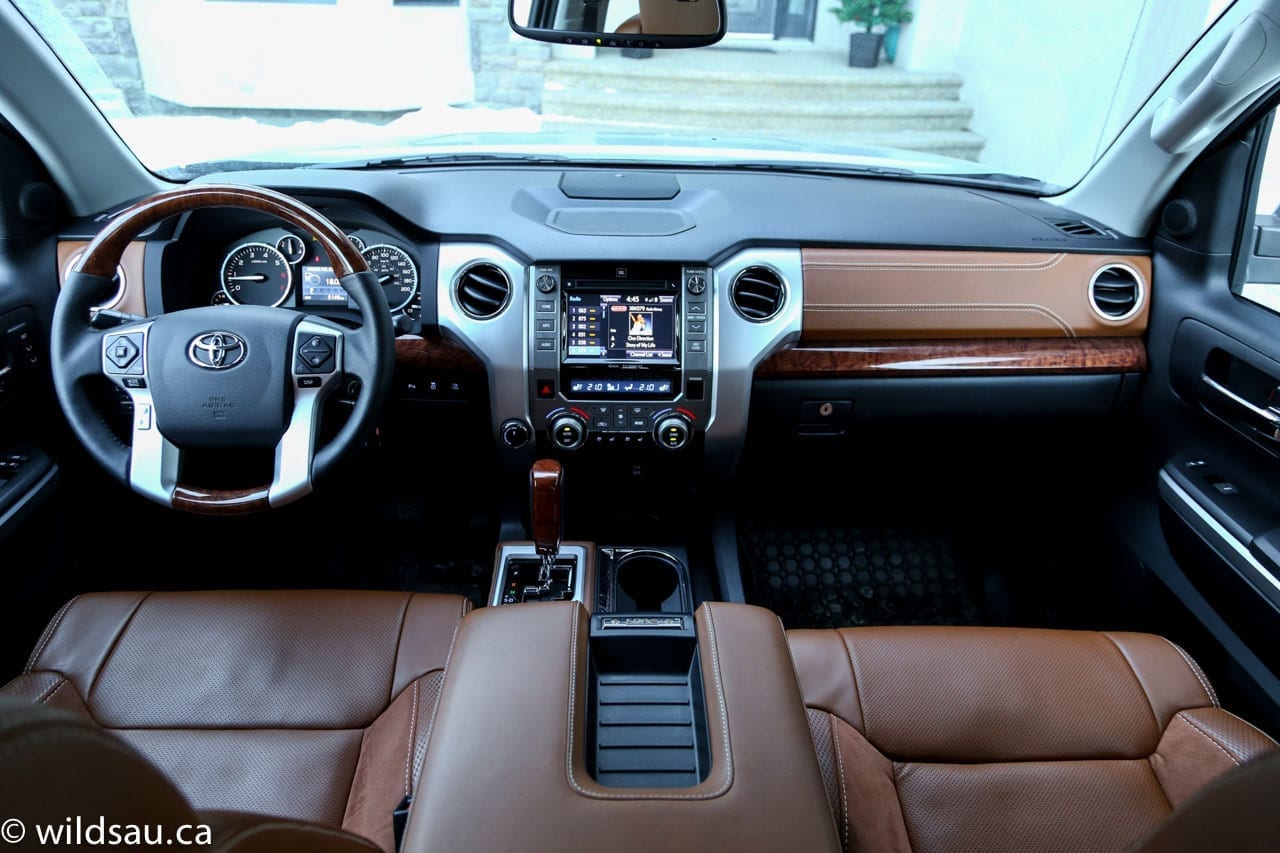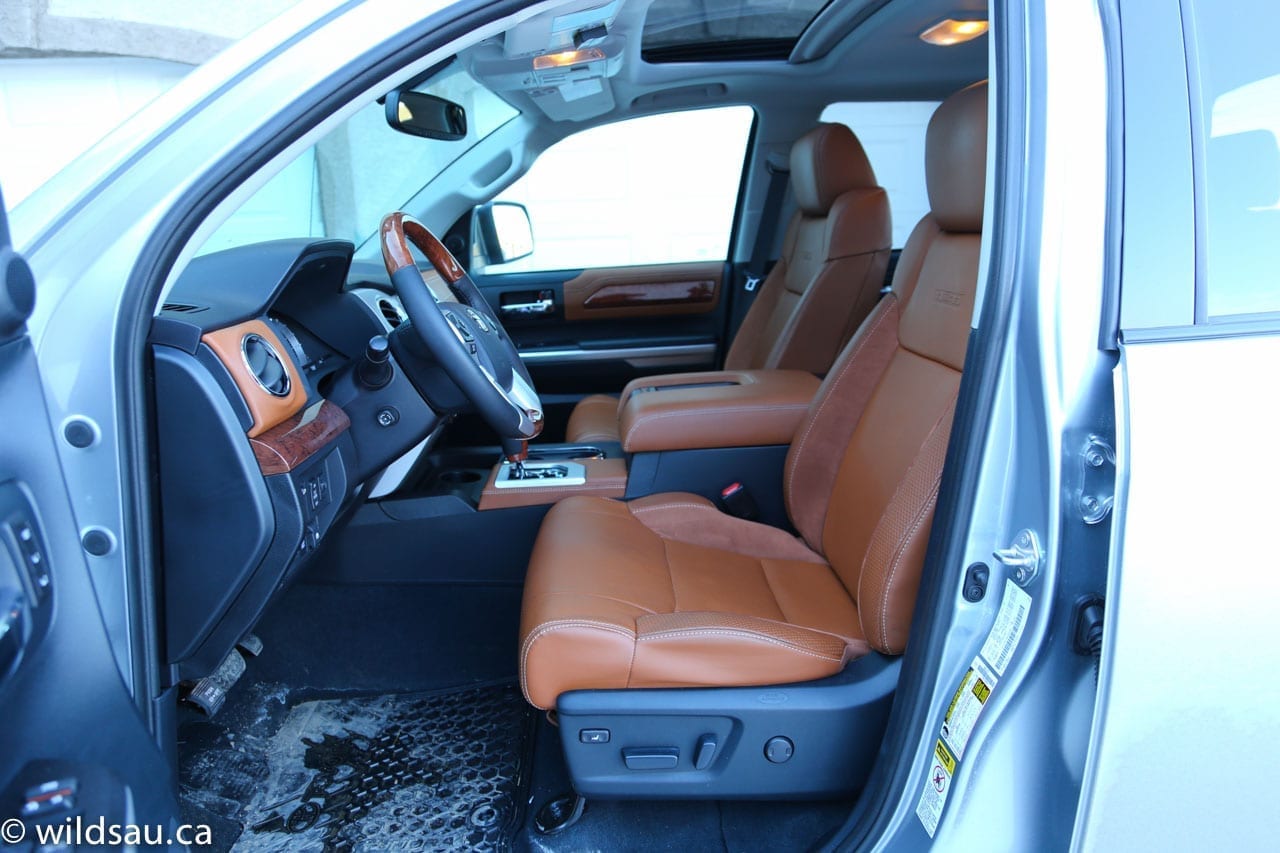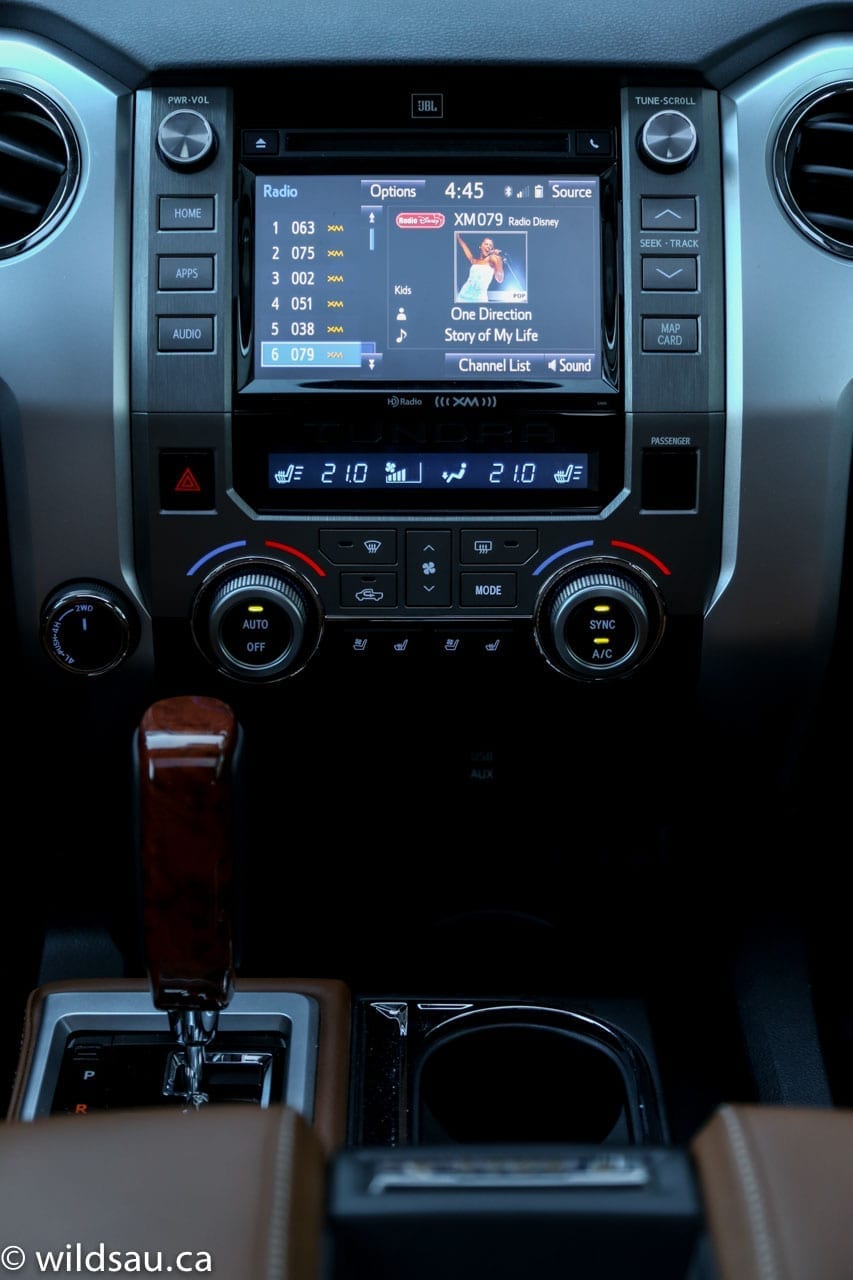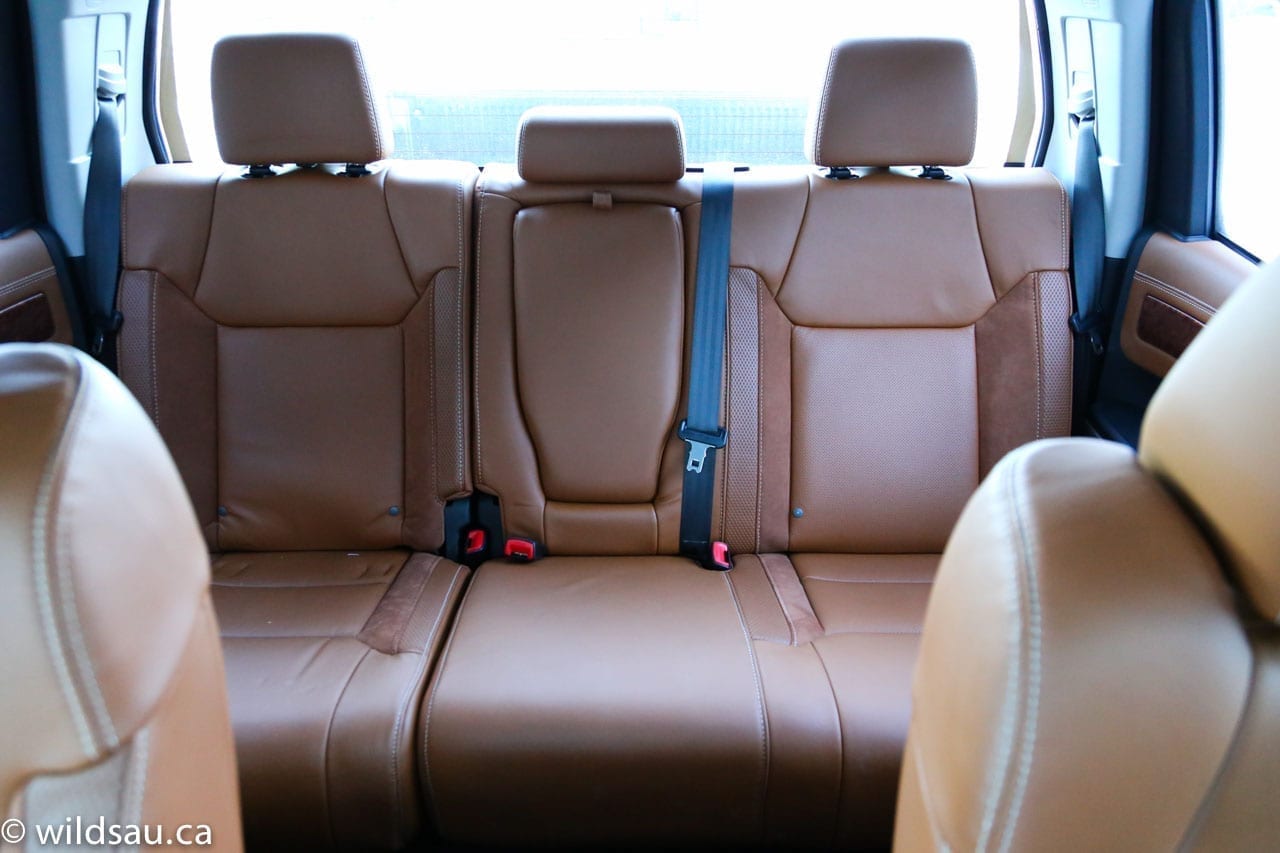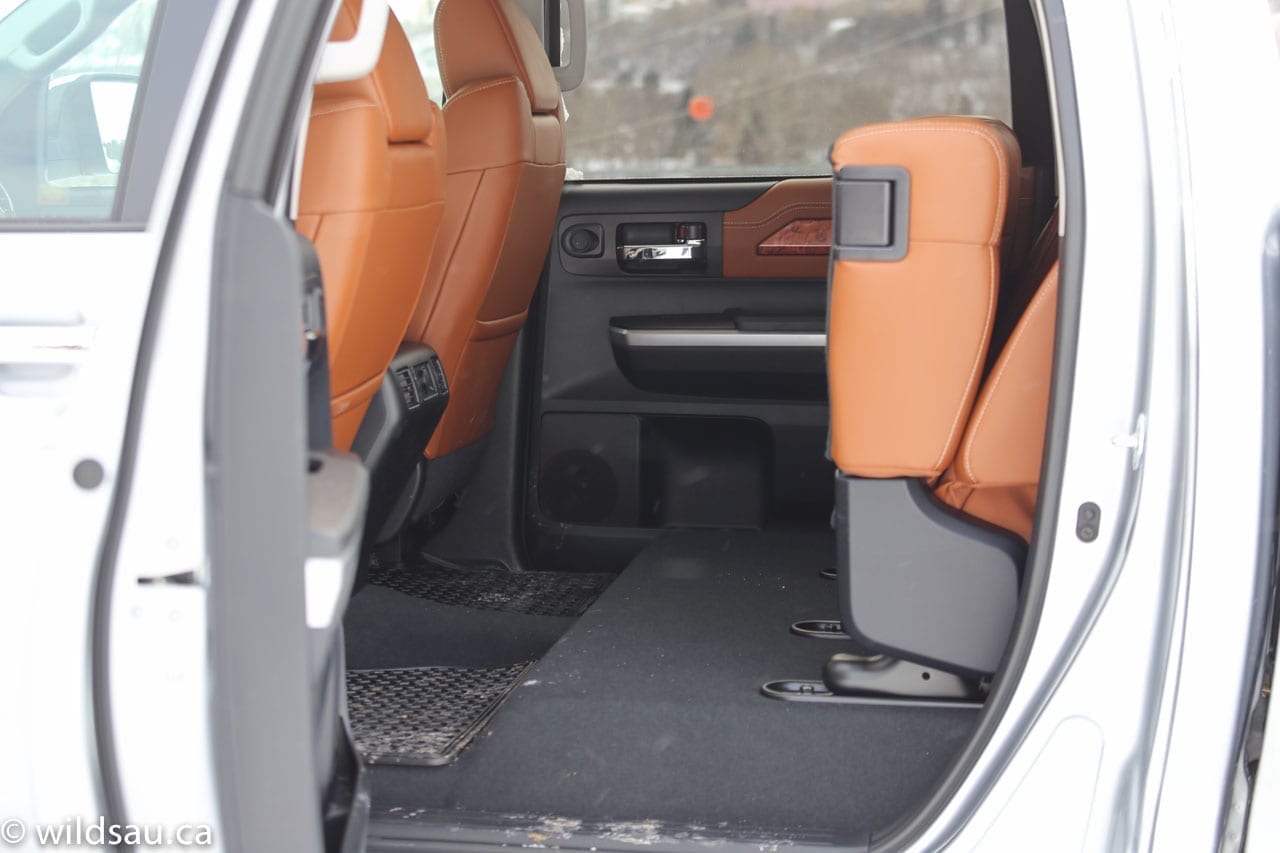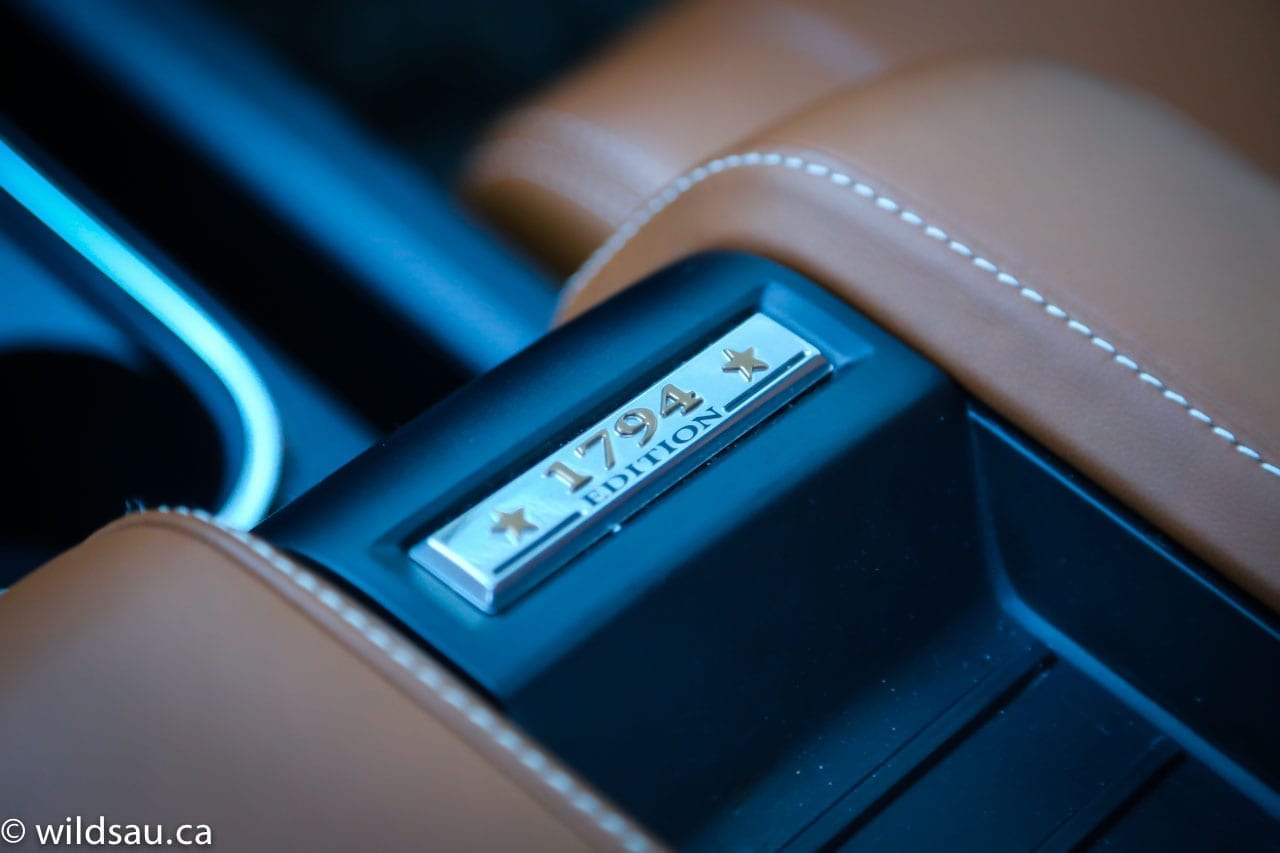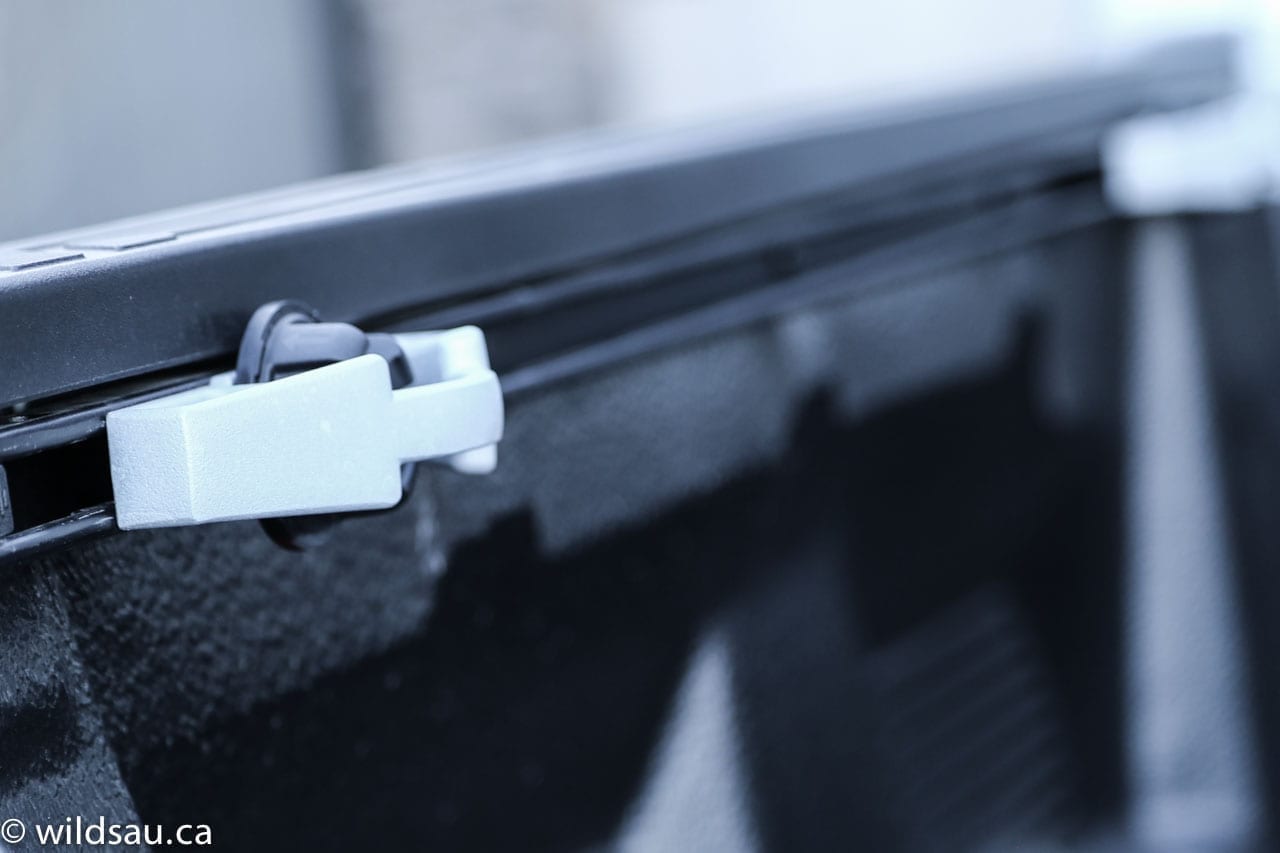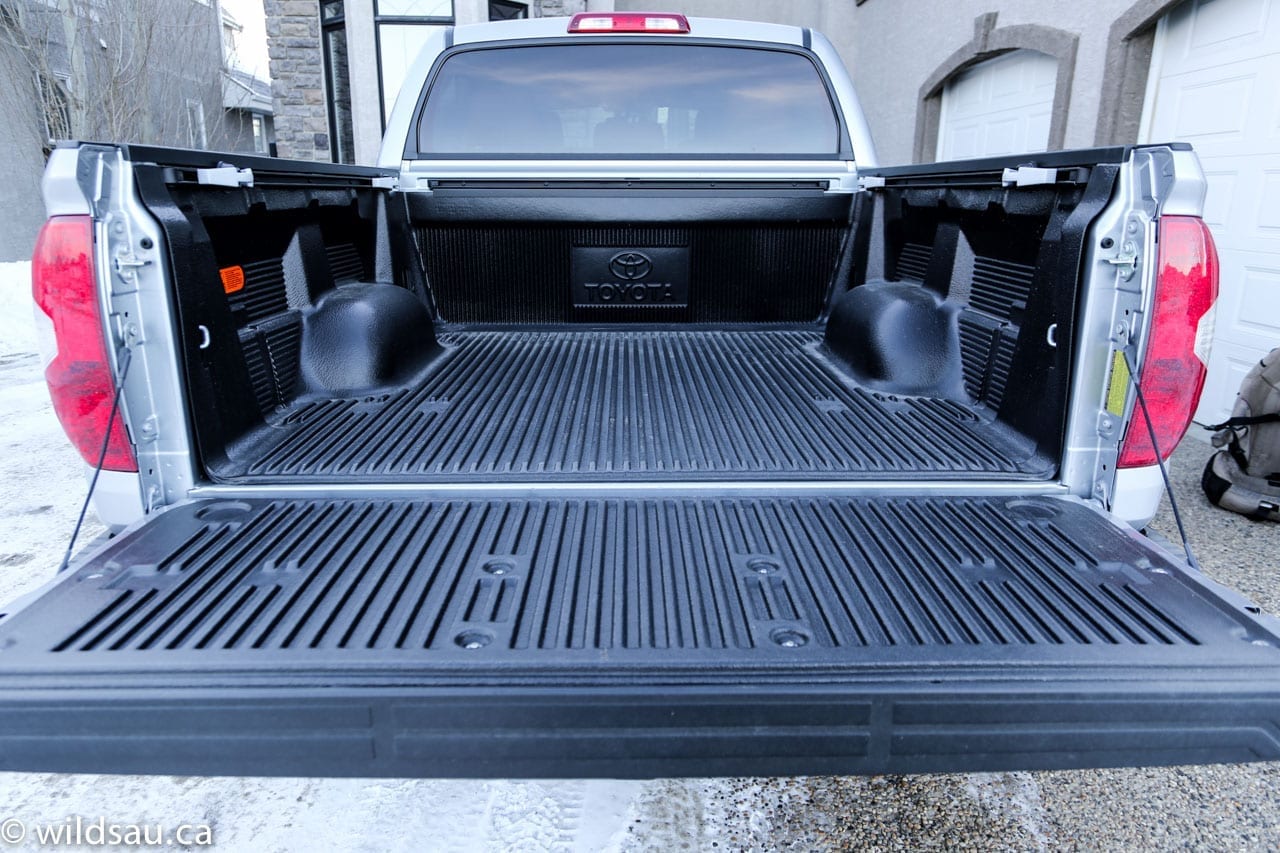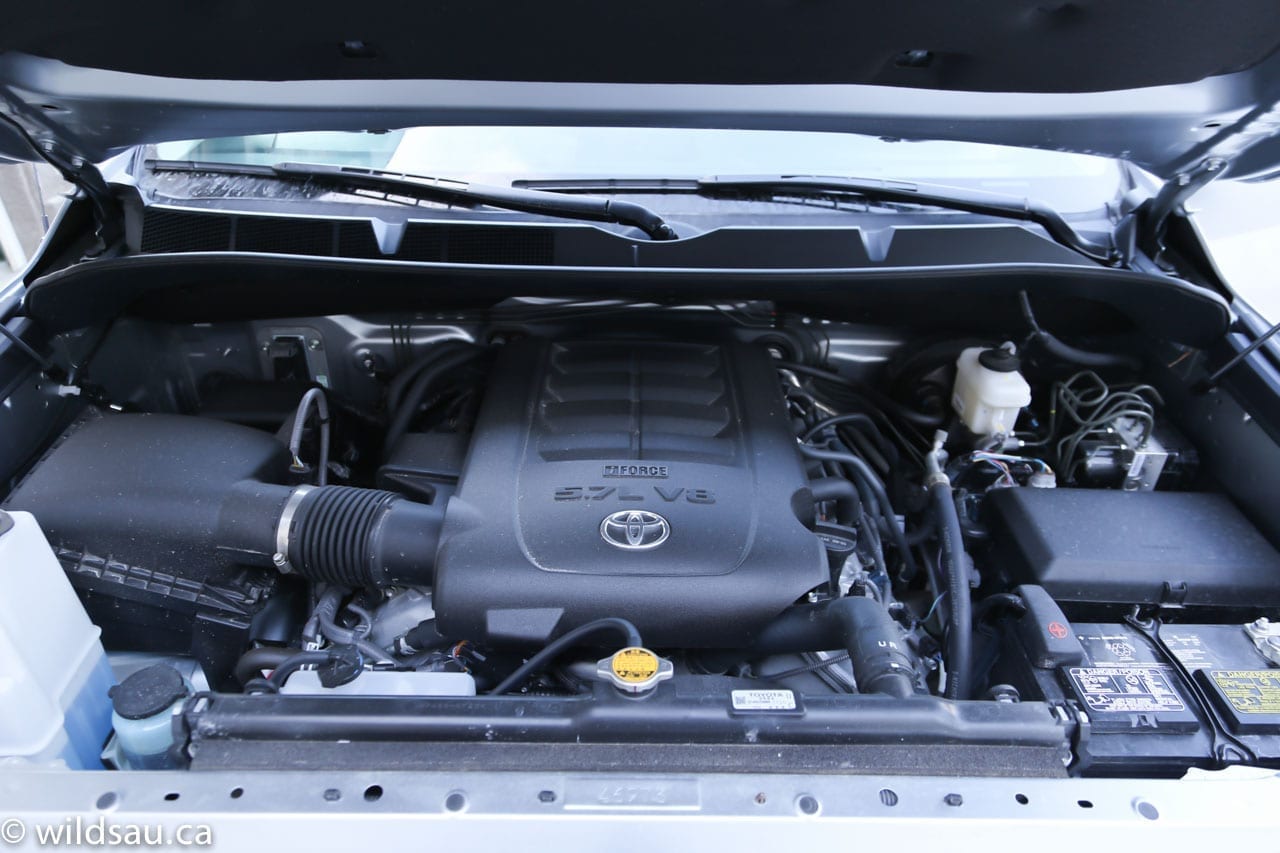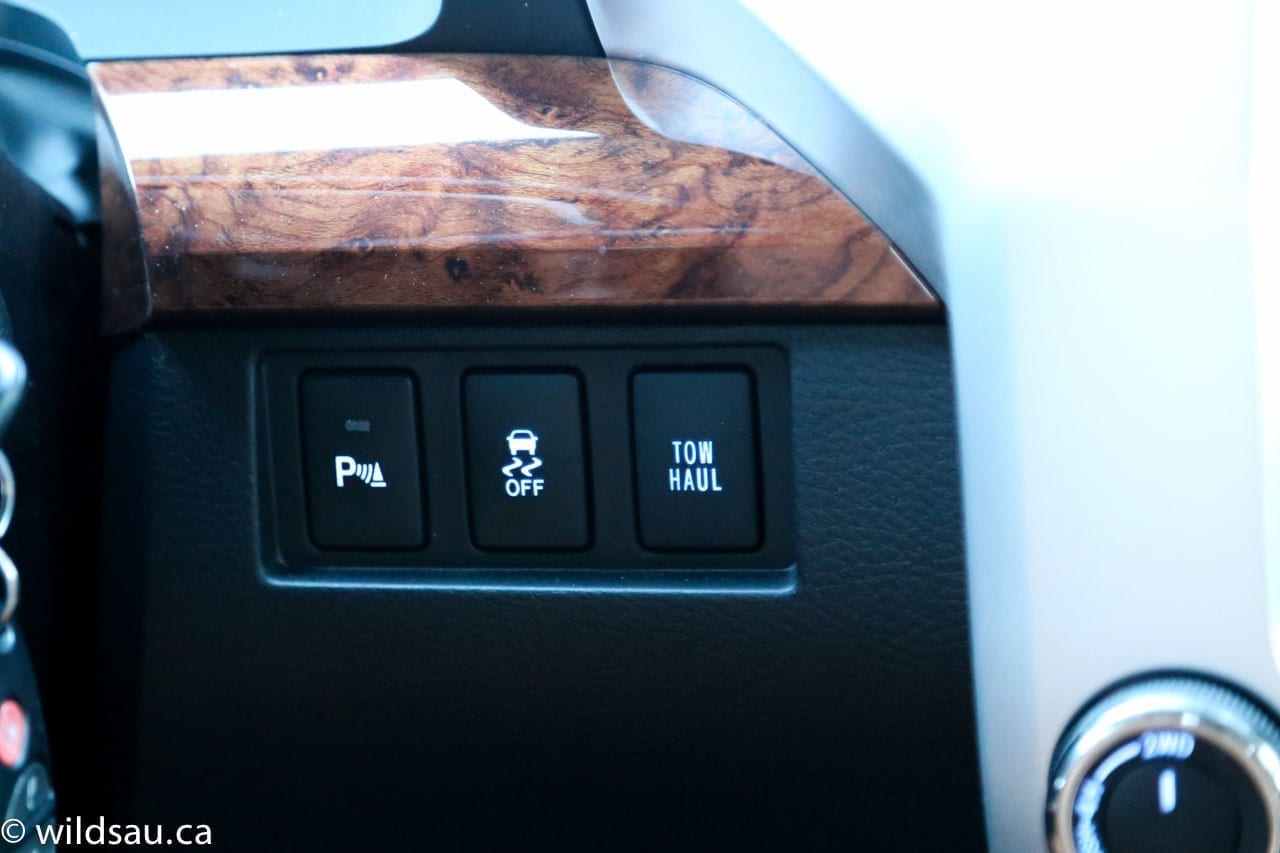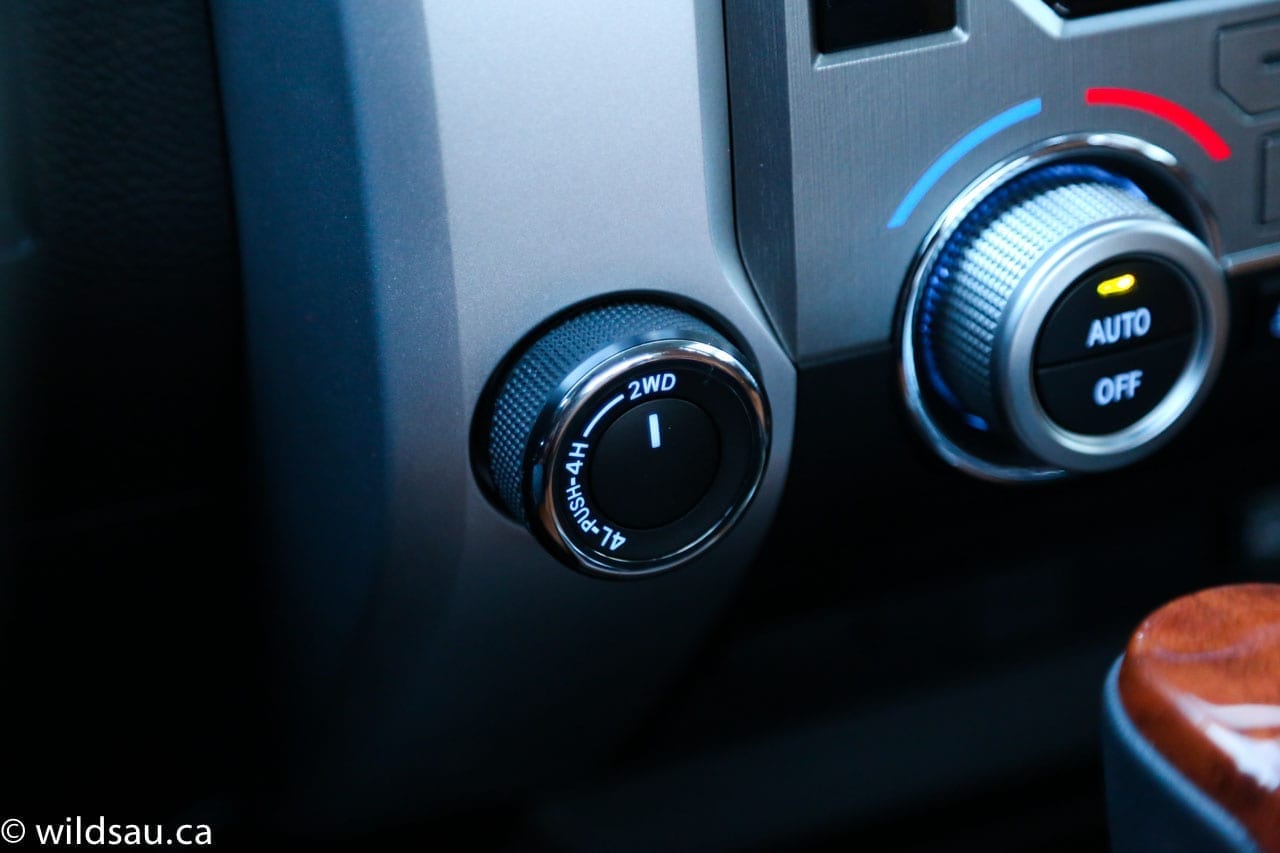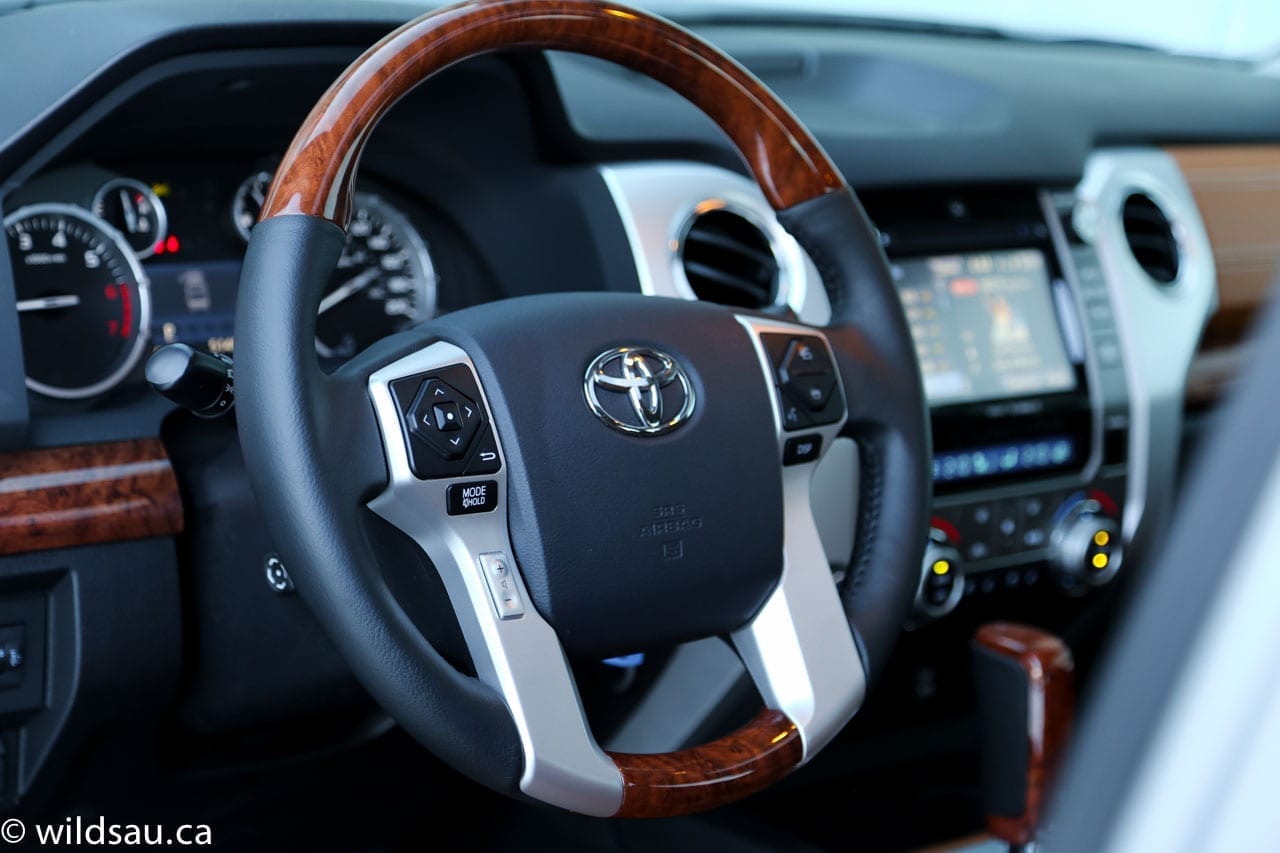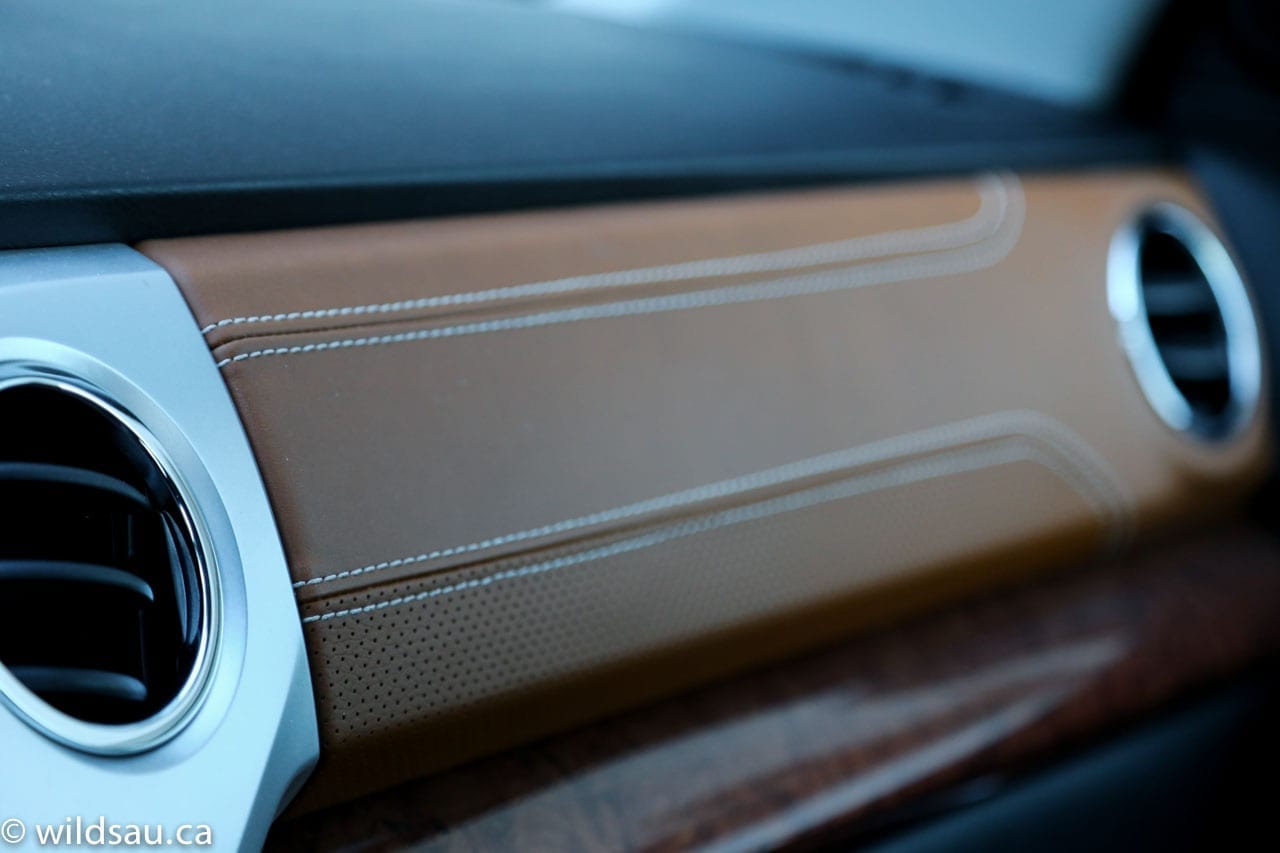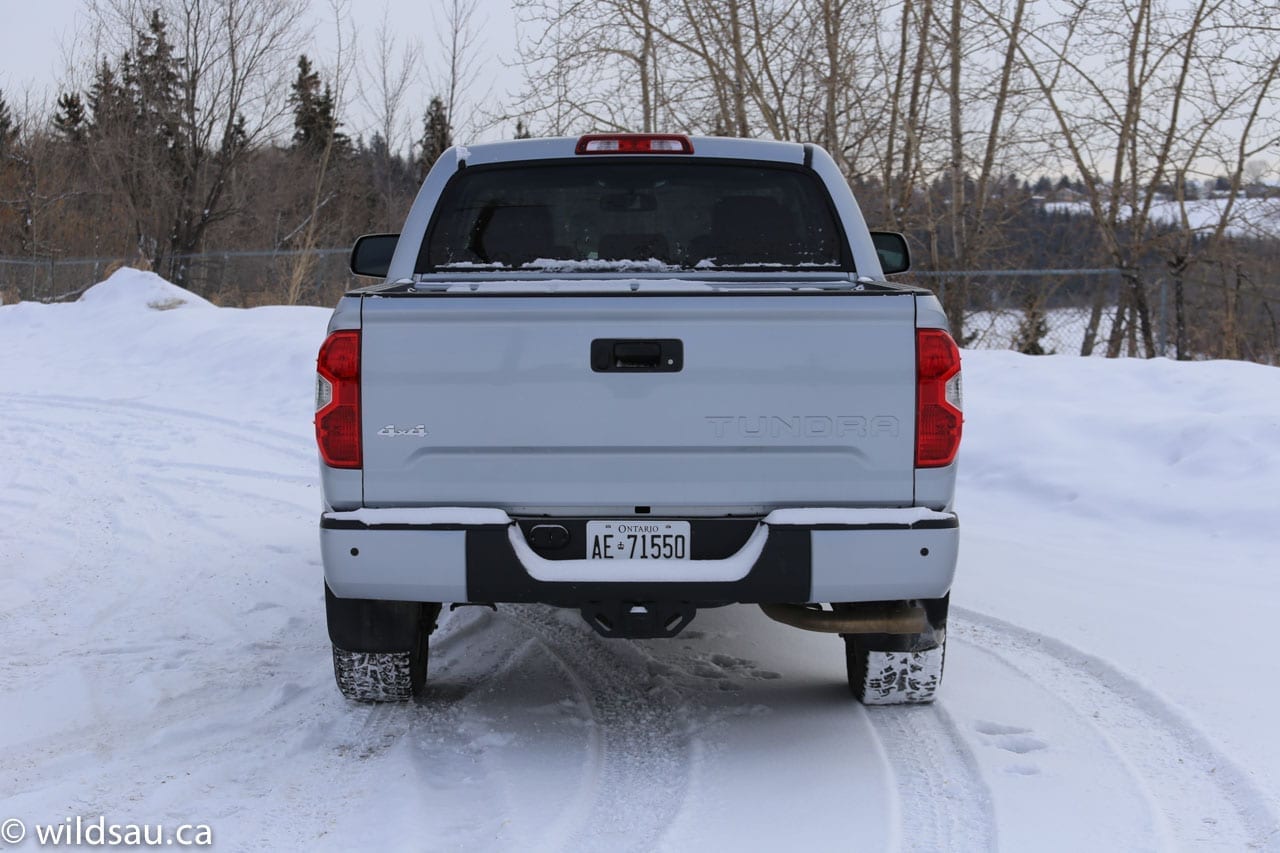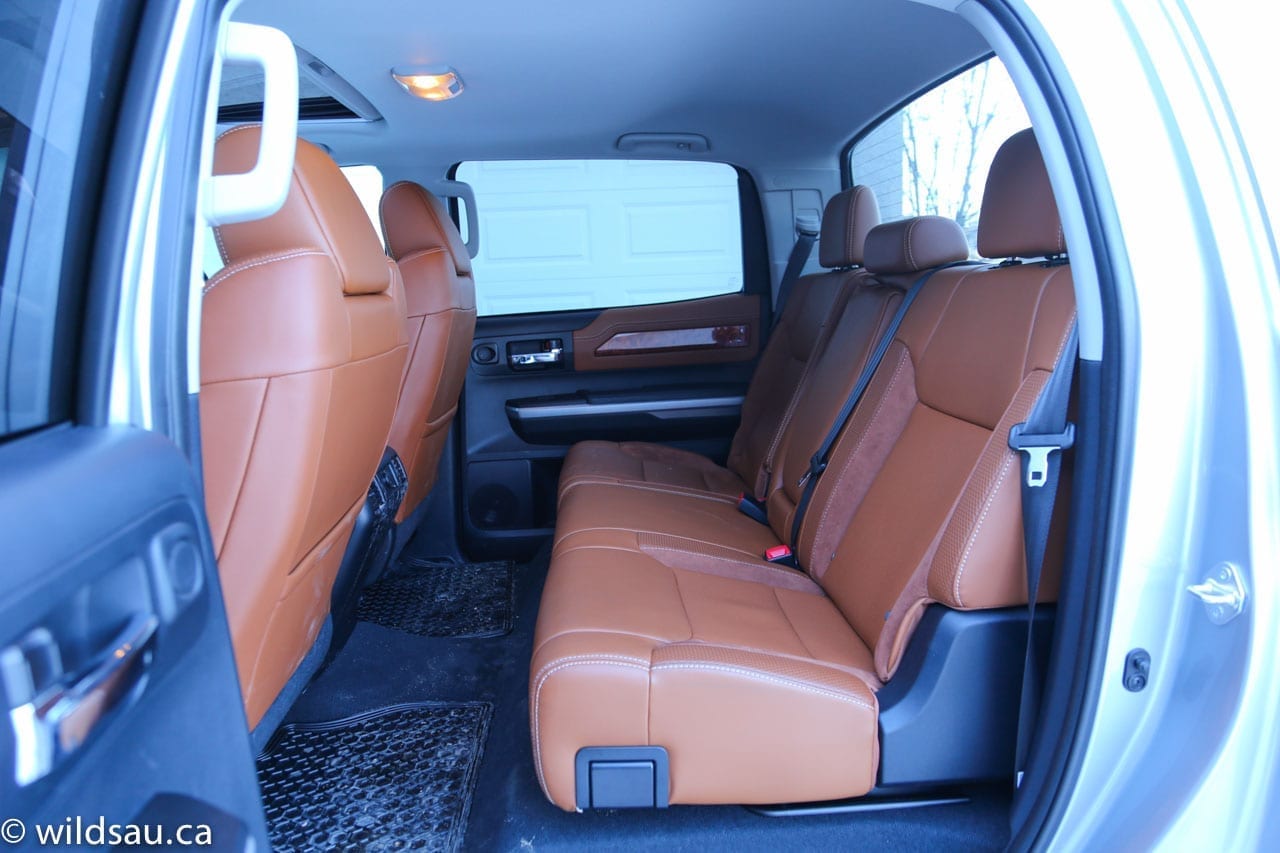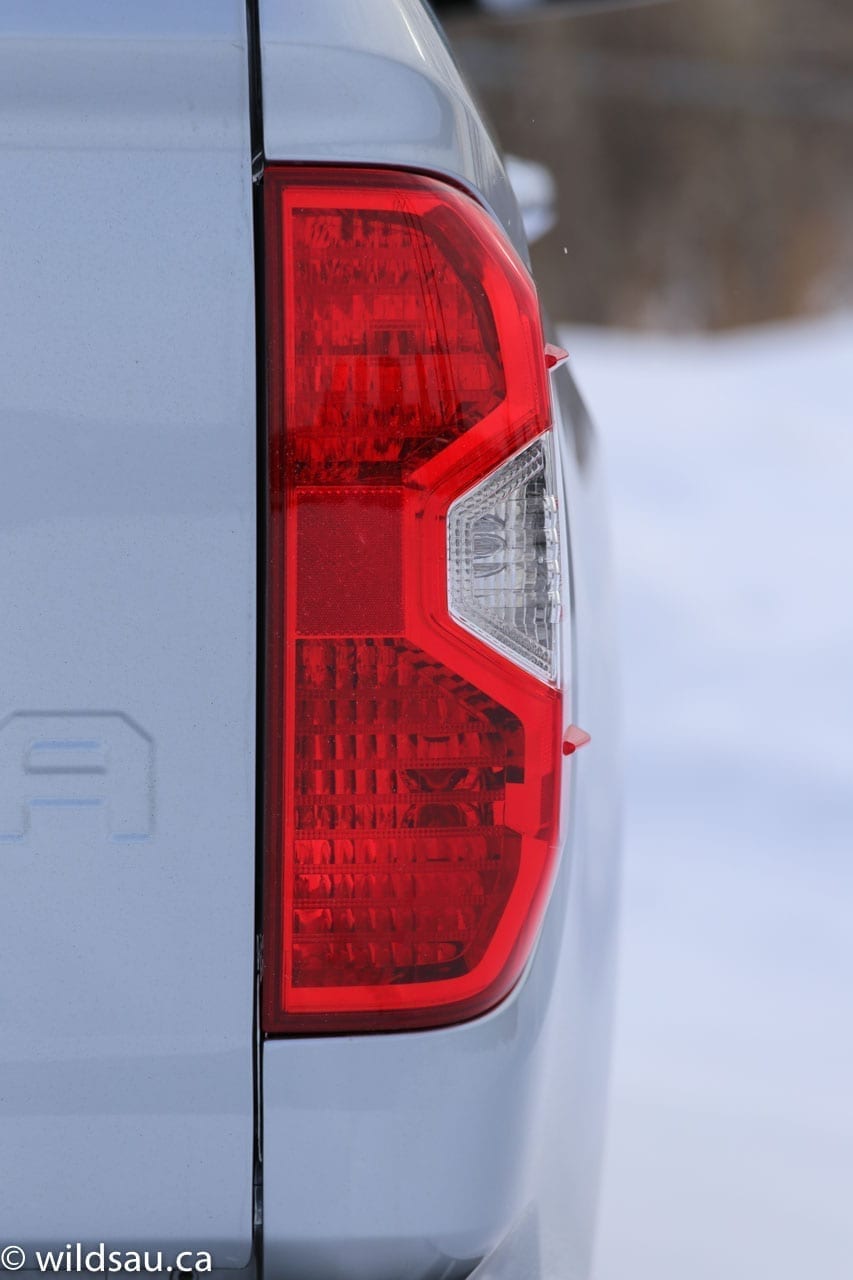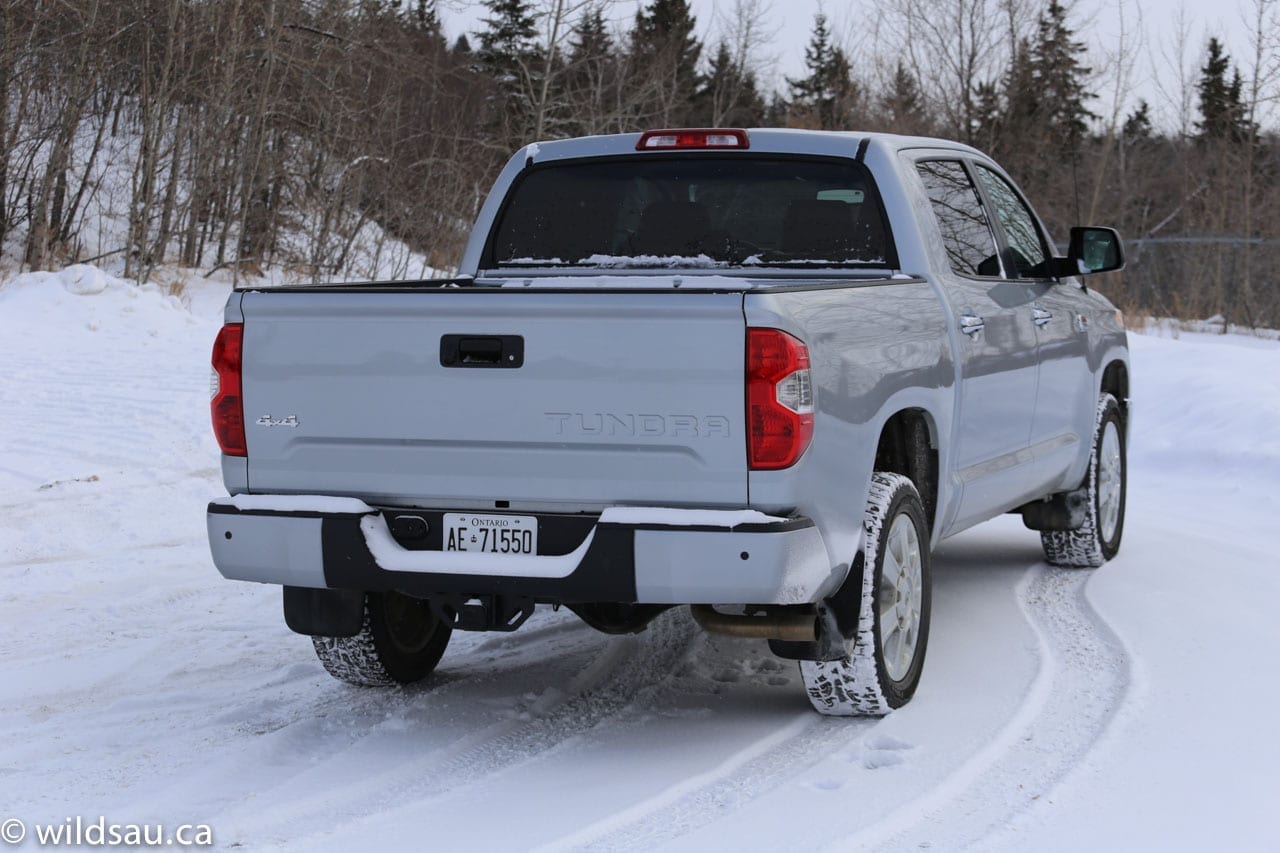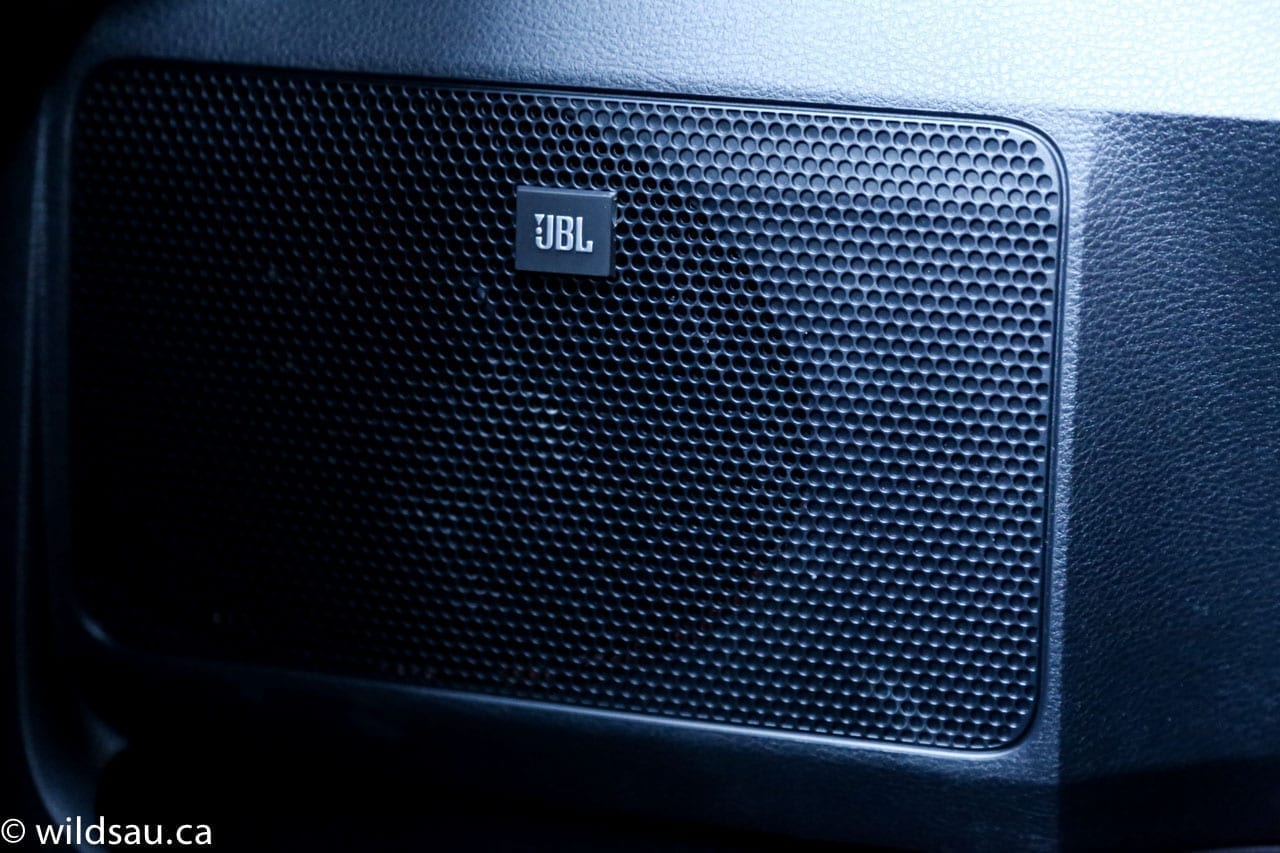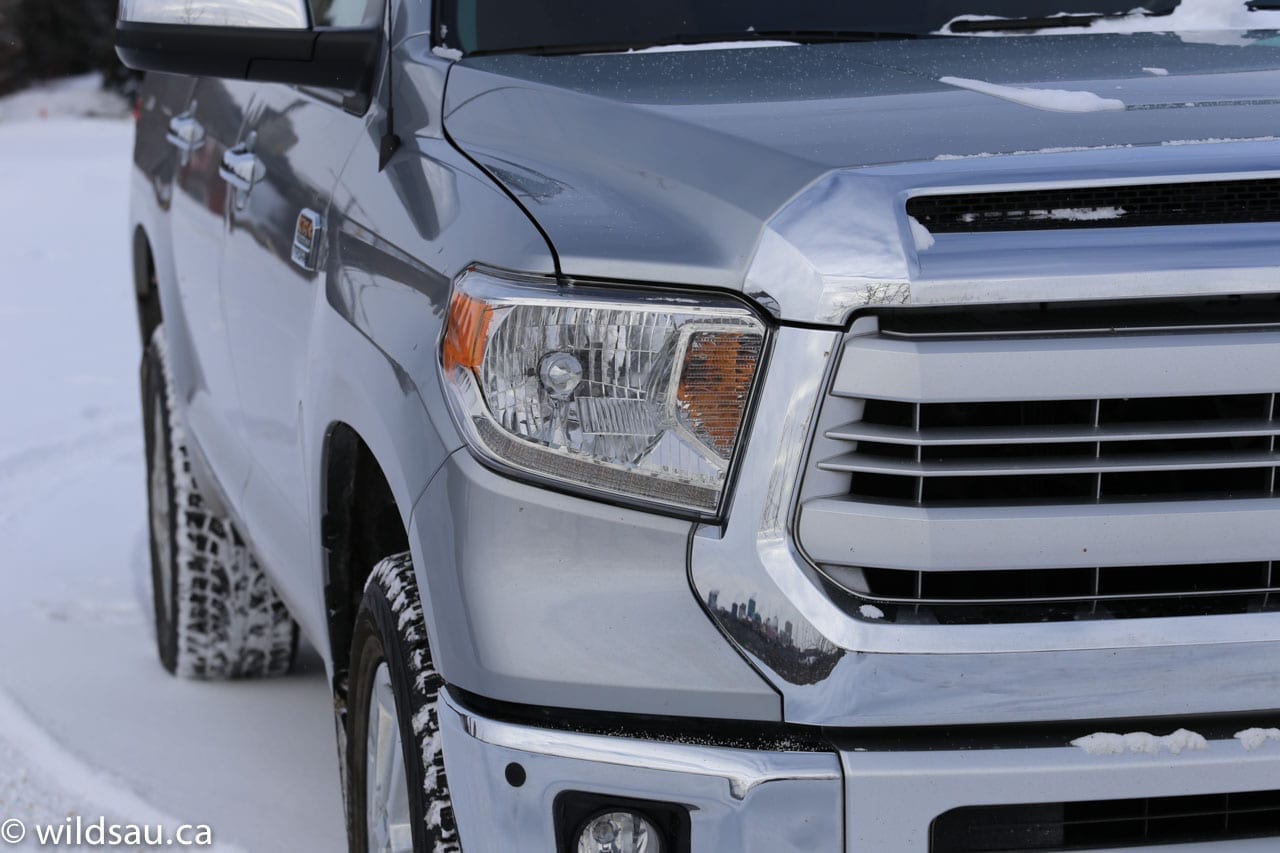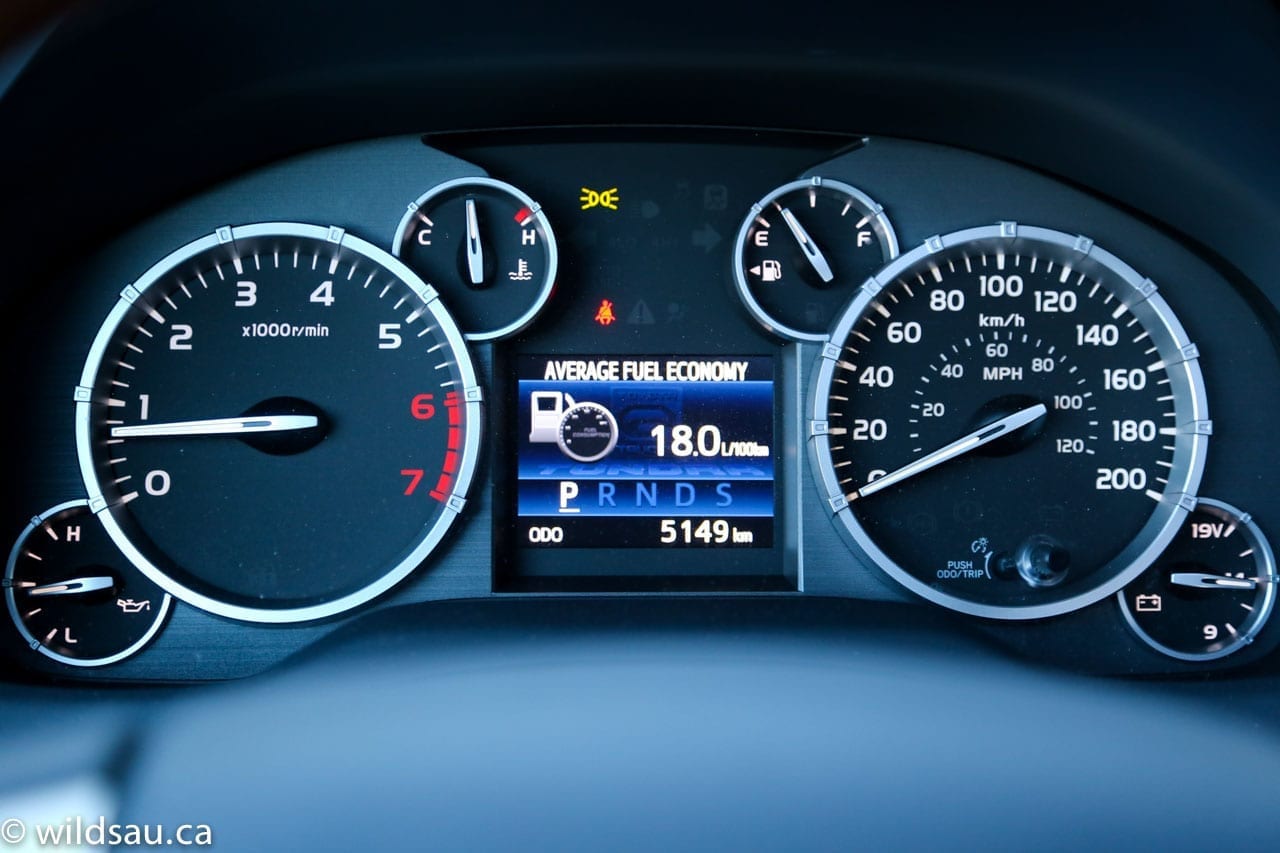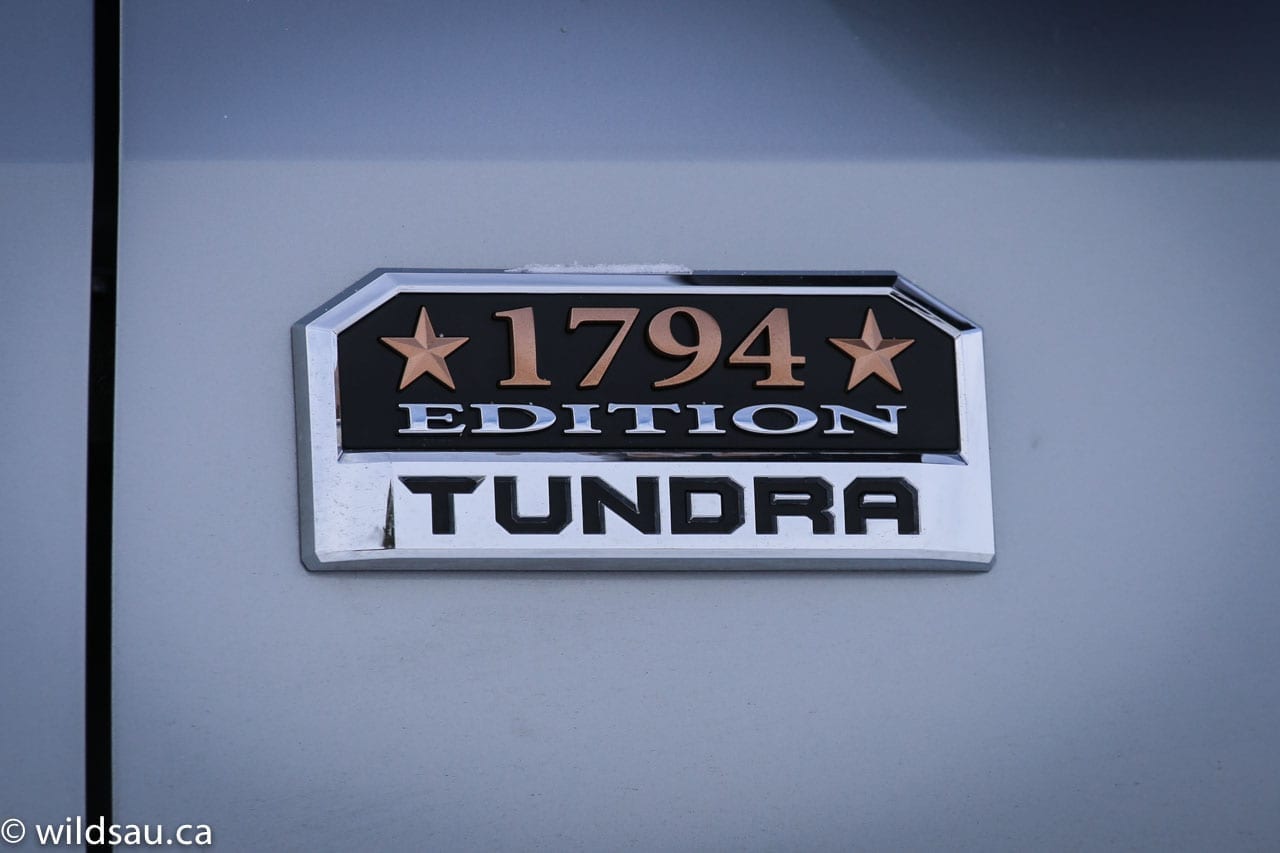On paper, the 2014 Toyota Tundra does a great job competing head-to-head with the big hitters in the full-size truck class. Is it as competitive in the real world?
Pricing: 2014 Toyota Tundra Crewmax
Base price (Crewmax Platinum 5.7L trim): $53,700
Options: $300 1794 Edition trim
Freight: $1,690
A/C tax: $100
Price as tested: $55,790
Exterior
When you compare it to the previous generation, it looks like Toyota’s aim was to create a more masculine truck. It comes across as more chiseled, squared-off and somewhat angry. The bright strip of LED driving lights grab your eyeballs and the massive grille is something to behold – you can see it a mile away. The side profile gets integrated fender flares that look bigger and more squared off to me.
The tailgate has the Tundra name stamped into the steel, rather than being adorned with less manly badging. I really liked the huge 20-inch rims, in this case shod with 275/55-sized gummies. Although it’s easily recognizable as a Tundra, and has been given a somewhat polarizing über-masculine style, the new Tundra definitely looks better than the outgoing model in my opinion.
Interior/Tech/Convenience
Toyota made some changes inside too. Hard plastics make up the dash (similar to the majority of the competition), and styling is simple and attractive. Fit and finish seemed a bit lacking as I often heard some plastic on plastic buzzing and some rattling over bumps as well.
My tester’s 1794 interior trim, which clearly takes cues from Ford’s King Ranch trim, is pretty handsome – it gets tan saddle leather seats (with suede inserts), as well as dash and door panels, and an armrest upholstered in the same stuff. You’ll find all the expected gauges and a driver information screen in the middle, and a power-adjustable steering wheel. The steering wheel isn’t heated – a bit surprising at this price, especially since most of the competition has it. I found those pretty leather seats (which are power-adjustable, heated and ventilated!) very comfortable, even for long distances.
Some of the main controls on the centre stack are chunkier, making them usable with gloves. The 7-inch touch screen is a bit of a reach, but it works well, handling the audio, phone, navigation and vehicle settings. Toyota makes a big deal about the JBL sound system – it has a ton of speakers and plays your tunes from any kind of input you can think of – it sounds alright, but didn’t overly impress me. There’s also a dual-zone automatic climate control system and a sunroof.
Rear Seats
In the back you’ll find three seats, each with a seatbelt and a headrest. There is space for three adults with head room and leg room to spare which means the rear seating was definitely wide enough to accommodate our three kids – that includes two child seats (there are two sets of LATCH anchors for that purpose if you need them).
Rear passengers get adjustable air vents, a 12V plug and an armrest that folds down out of the middle seatback.
In terms of cargo capacity, you’ll find that the seat bottoms fold up and out of the way (in a 60/40 split), creating a massive open cargo space with an almost flat floor. This is very convenient for moving a lot of stuff. The rear window is powered, allowing it to vertically slide open (and out of the way) – very cool!
Storage/Work
These days, trucks are often mobile offices. Which means they need places to put stuff, and conveniences to get the working person through their day. The Tundra gets a big glove compartment, good door bins, and an organizational space at the front of the centre console where you’ll also find two 12V plugs (and the USB and aux inputs). There are little smartphone-sized drop-in bins – one on top of the dash and on top of the armrest lid. Speaking of the armrest – pop the lid open and there’s a massive open space under there (with another 12V plug). When it comes to staying hydrated and caffeinated, there are three cupholders in the console.
Irritatingly, there are no 120V household plugs to be found. The competition offers them, and frankly the old-school 12V plug should be headed toward extinction. This is a major oversight, especially when you compare it to the massively charger-ready console of the new GM trucks.
In terms of payload, the 5.5-foot box seems well-designed. It gets a very bright utility light, and a soft-open tail gate that I loved. No more banging the tail gate down. Just let it go, and it gently lowers itself.
I liked the adjustable tie-down hooks on rails situated on either side of the box. They complement the stationary tie-down loops throughout the box and make load management easy.
The Tundra’s towing package includes a hitch receiver, both sets of trailer plugs, various drivetrain cooling elements and strangely, wiring for a trailer brake. Unlike the competition’s built-in solutions, you need to use a third-party unit.
Under the Hood
The business end of things remains basically unchanged. There’s a smaller 4.6-litre V8 available, but I reviewed the massive 5.7-litre V8 that counts for the majority of the Tundra’s sales. Numbers are impressive: 381 horsepower at a lofty 5600 RPM and 401 lb.ft of torque, available at 3600 RPM.
The Tundra retains its 6-speed automatic transmission and an electronically-controlled 4WD transfer case. It comes as no surprise that that kind of powertrain, lugging around a 2575 kg (5677 pound) truck isn’t going to make for good fuel economy. People don’t buy full-size trucks to save on gas. The Tundra (in this configuration) is rated at 16.3 L/100 km (14 mpg) in town and 11.9 L/100 km (19 mpg) on the highway. I averaged a thirsty 18.1 L/100 km (13 mpg) while (sadly) driving with a fairly light foot. Of note, this did include a lengthier highway jaunt and did not include any towing. No, it doesn’t take long to drain that 100-litre tank.
The Drive
The Tundra feels substantial and big and when it comes to the driving experience, I’d use the word smooth to describe almost everything it does. That big V8 sounds terrific under load, and it’s plenty powerful off the line – actually in any situation, once the transmission kicks down. That transmission is lazy, but that’s no different than other full-size rigs – the shifts are buttery smooth every time. There is a sport mode that hangs on to gears longer, and it can also be shifted manually with the gear selector.
I found the ride to be excellent – luxurious and well-controlled with little of the wallowing around corners that one expects from a truck, it soaks up big hits on and off road, letting nothing come through to the cabin. Of course there is plenty of lean in corners, but road-holding abilities are excellent when it matters. The Tundra is quiet too – road noise, engine noise and wind noise are all nicely dampened, even at highway speeds.
I was able to get some towing in right off the bat. The Tundra has a maximum towing capacity rated at 10,200 pounds depending on configuration – this one’s rating comes in at 9,490 pounds. I helped move a big boat on a trailer, a rig that weighs in at over 5400 pounds. Equipped with the 5.7-litre V8 and its 4.30 axle ratio, the Toyota felt very powerful off the line and continued with nice, linear power delivery right up to 105 km/h. I tried towing with and without the tow-haul mode – it definitely made a difference and seems to be effective. Using my iPhone app, I clocked it at approximately 16.3 seconds for the 0-100 km/h run while towing which I thought was impressive. The truck felt level and stable, and the brakes were powerful and quick, considering we did not connect a trailer brake. Overall, I found it to be very easy to drive while towing. I’ve read of complaints regarding previous-generation Tundras that feel like the frame flexes and twists while towing loads – I did not get that sensation.
With all that said, it did not feel as powerful or fast as the Hemi-powered Ram 1500 we towed the same boat with, and very subjectively (since I tested its towing abilities several months ago) it also didn’t feel as powerful as the EcoBoost-powered F-150. In any event, I would say the Tundra has all the power you’d ever need in a half-ton truck when it comes to recreational or work-related towing.
Its 4×4 system is effective – its traction was immediate on Edmonton’s snowy and icy surfaces. Rear-wheel drive, 4HI and 4LO are accessed with a rotary dial on the dash.
Parking anything this size isn’t fun, but the back-up camera and the front and rear parking sensors (with audible and visual aids) as well as the power-folding mirrors make a big difference in putting this leviathan into its place. Backing out of parking spots and driveways got a little safer too, thanks to the rear cross-traffic alert system. On the open road, the blind-spot monitoring system helps you from running over the little people in the lane next to you – there’s a big blind spot on the passenger side.
A nitpick – the Tundra took a surprisingly long time to heat up. With a big V8 like this, one would think it would be cranking out heat in a minute or two, and its competitors do just that. I parked it outside, and it took 10-15 minutes to start warming up on cold mornings. And that sucks.
The Verdict
Toyota has built the Tundra for some time now. And it’s a good truck. It does a lot of things very well, and it has proven itself to be epically reliable in this class. There are a few oversights that surprised me, but if you were to buy this truck, you wouldn’t be disappointed.
I give the Toyota Tundra a 7 out of 10.
I think the bigger question is, can Toyota convince the truck-buying public (that’s about a quarter of my province’s population, it seems) that it really is a big truck and a viable alternative to the players from Ram, Ford and GM? It will certainly hold its own in terms of on-road performance, it has decent off-road chops for a full-size truck and it has what it takes to be a work truck. I’m convinced.
But you can tell all of that to someone who’s bought Fords or GMs their entire life, and you can show them all the specs on paper, and present them with all the objective evidence – and throw in a test drive to boot – and they could very well remain unconvinced. Heck, you could even tell them the Tundra has been designed, engineered and manufactured in North America – and this still wouldn’t be enough to sway them. And therein lies Toyota’s biggest hurdle.
Disclosure: Vehicle was provided by Toyota Canada.
If you enjoyed this review, feel free to check out my other vehicle reviews under the car reviews tab at the top of my blog.
My reviews of some of the competitors: GMC Sierra, Chevrolet Silverado, Ram 1500, Ford F-150

